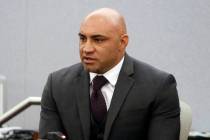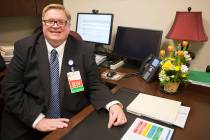Wondering why the will to live fades away
It eats at Dr. Michael Casey when someone with minor injuries dies, seemingly giving up the will to live.
How can someone with a few broken ribs, an individual who received excellent medical care after what first responders referred to as a non-life-threatening car accident, pass away after injuries that aren’t close to a physiological reason for death?
“It really disturbs me,” he says as he stands inside the UMC Trauma Center. “I wish I could do something about it.”
The piercing sound of an ambulance siren draws closer as Casey talks about the will to live, a subject that has been debated and studied for years by scientists and sociologists, philosophers and psychiatrists, clergy and caregivers.
We all have a will to live, Casey agrees, yet why that will sometimes appears so frail remains a mystery to him.
This surgeon knows what he can, and cannot, do. He was honored last year for heading the team that undid horrific damage to a motorcycle accident victim’s aorta, trauma that is fatal 98 percent of the time. Their patient is now back at work.
“I can fix the mechanical problems with people,” he says as casualties from another accident in Las Vegas are wheeled in. “But I can’t fix the problem they may have with the will to live. … I don’t understand why some people just give up, what brings them to that point. … There is a big psychological component, there has to be, underneath.”
UMC trauma surgeon Jay Coates has seen the same phenomenon. A patient who is stable, nowhere close to dying, inexplicably takes a turn for the worse and dies. When he sees the patient isn’t from a happy home, he wonders if it is because the individual may feel all alone in the world, with no loving spouse or family to turn to, with seemingly no purpose to go forward.
“It’s hard to describe but you sense that they’ve given up, that they see no reason to stick around,” he says.
It troubles these doctors that self-preservation, a fundamental urge in nature, somehow disappears in some trauma victims. More troubling is the sense they are seeing a growing number of patients with a conscious will to die.
These are not people just hanging on after a horrific accident, lingering between consciousness and unconsciousness. They know what’s going on.
Casey has seen it with patients who come in after a slip and fall. There is absolutely no reason, he says, for them to think that their injury, often a minor fracture, is a catalyst for death.
“With older people, I’m seeing it quite a bit more,” he says. “Emotionally it (the fall) just seems to be too much. They just give up and die. I sense that it will be a relief for whatever they’re going through in their lives.”
For years researchers have studied individuals undergoing all sorts of negative experiences, many of which may be demoralizing, hurtful or tragic and the question of why the will to live remains alive and well among some people remains an ongoing question.
It’s pure speculation whether what Casey reports is a variation on a phenomenon widely reported last month –– suicide rates among middle-age Americans have risen by nearly 30 percent in the past decade. More people now die of suicide (38,364) than car accidents (33,687).
Yet when you hear what Rutgers University sociologist Julie Phillips has to say about the increase in the suicide rate among baby boomers, you can’t help but wonder if the tragic outcomes Casey reports from a trauma center aren’t cousins to self-inflicted harm:
“The boomers had great expectations for what their life might look like, but I think perhaps it hasn’t panned out that way.”
Is the “relief” that Casey describes among those who seemingly will themselves to die from minor accident injuries much different than what some researchers describe as the “relief” sought by baby boomers who die from self-inflicted wounds?
Casey, who quarterbacks medical teams that see death as a defeat, calls what he’s been seeing a “troubling mystery.”
And he asks troubling questions.
“Have these people really had that hard a life? How did life get so bad for them?”
Contact reporter Paul Harasim at
pharasim@reviewjournal.com or 702-387-2908.


















